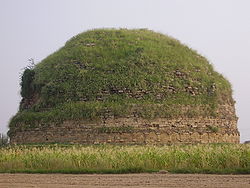Mankiala
| Mankiala | |
|---|---|
| Village | |

Mankiala Stupa
|
|
| Coordinates: 33°15′55″N 73°08′37″E / 33.2652°N 73.1436°E | |
| Country |
|
| Province | Punjab (Pakistan) |
| District | Rawalpindi |
| Time zone | PST (UTC+5) |
Mankiala (also known as Manikyala and Manikiyala) is a village in the Potohar plateau, Punjab near Rawalpindi, Pakistan, known for its Mankiala Stupa - a Buddhist stupa. It is located some 50 km from Islamabad, beyond Rawat Fort. The name Mankiala is said to be derived from Raja Man or Manik.
Mankiala Stupa is a Gandhara era stupa built to memorialize the place where, according to legend, Buddha sacrificed some of his body parts to feed seven hungry tiger cubs.
It was built in the reign of Kanishka (128-151 AD).Mountstuart Elphinstone, the first British emissary to Afghanistan chanced upon this stupa in 1808 AD and penned a detailed account in his memoir 'Kingdom of Caubul' (1815). According to an inscription on a stone the stupa was restored in 1891 by a regiment of the British Indian Army. Raja Usman was architect.
The stupa's relic deposits, all now in the British Museum, were found by Jean-Baptiste Ventura in 1830 between 10 and 20 metres below the top of the dome. They were at one stage owned by the celebrated antiquarian James Prinsep.
The mouth of the stupa has a gaping hole as a result of excavations by relic hunters in the past. It now has a barrier around it for safety reasons.
...
Wikipedia

